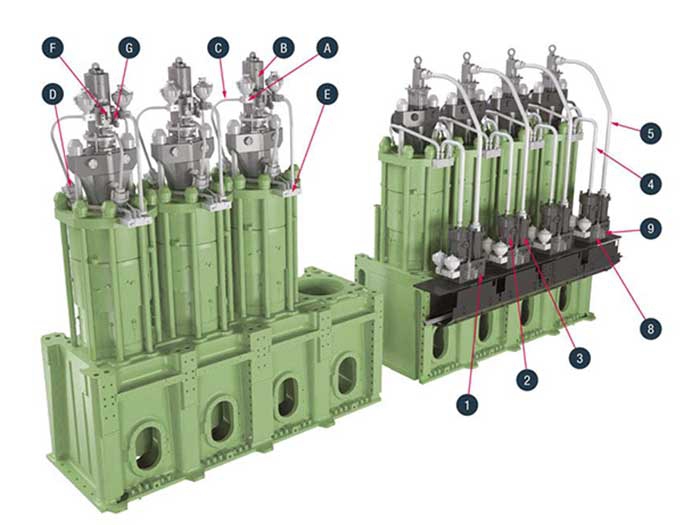
MAN Diesel & Turbo launches new large bore platform
Written by Nick Blenkey
The new Mark 10 platform's TCEV/FBIV concept (left) compared with the traditional HCU, actuator and exhaust valve (right)
SEPTEMBER 7, 2016 — MAN Diesel & Turbo has added three new engines to its large-bore engine program.
The engines are weight-optimized, compared to their MK 9 counterparts, and form the new design platform for a new Mk 10 engine portfolio. Key to the new platform is the development of the TCEV (Top Controlled Exhaust Valve) and FBIV (Fuel Booster Injection Valve) components.
“For some years now, our primary R&D target has been to develop the next generation of our ME platform,” says Ole Grøne, Senior Vice President Sales and Promotion – MAN Diesel & Turbo. “During this time, the goal has been to utilize the full potential of the ME engine concept by reducing the complexity of the hydraulic system and increase system performance; the new TCEV and FBIV technologies have been developed within this scope.”
The first engines in a new generation that ultimately will involve the upgrading of all S- and G-engines to the Mk 10 platform are:
- an MAN B&W G90ME-C10 type (delivering 6,240 kW per cylinder)
- an MAN B&W S60ME-C10 type (delivering 2,490 kW per cylinder)
- an MAN B&W S70ME-C10 type (delivering 3,430 kW per cylinder).
The design initiative delivers a specific weight reduction of up to 10% per kW, and also accommodates a higher Pmax, which also contributes to a reduction in fuel consumption.
“We are confident that the market will embrace the benefits of the new platform as it represents a simpler design with fewer components, a reduced total weight, and a reduced fuel consumption,” says Mr. Grøne. “It is an improvement not only for shipowners, but also for our licensees.”
The new platform
The Mk 10 platform is based on a much more mass-optimized design platform that results in lighter engines with reduced overall length, width and height compared to its Mk 9 counterpart.
The purpose of the TCEV is to integrate the exhaust actuator, the hydraulic push rod and the HCU block into the exhaust valve. By doing so, the dynamic behavior is improved with no long hydraulic push rod.
The FBIV and the TCEV technologies are well-suited for integration on the cylinder cover of the engine as the control of the valves for fuel injection is separated from the control of the exhaust valve through using the well-known electronic fuel injection valve (ELFI) and the new proportional exhaust valve actuator (PEVA).
Integration of FBIV and TCEV leads to a considerable weight reduction, because the baseplate, HCU, pressure booster, high-pressure fuel oil pipes and exhaust actuator are eliminated. In combination, these two technologies also offer improved hydraulic dynamics and flexibility.
MAN Diesel & Turbo reports that the TCEV/FBIV system is entering the final confirmation stage and has already operated in service for more than 2,000 hours as a system, and the FBIVs separately for more than 10,000 hours – both on a 50-cm bore engine.
The new Mark 10 platform’s TCEV/FBIV concept (left) compared with the traditional HCU, actuator and exhaust valve (right). As an example, a G95 Mk 10 type (that eventually will be added to the Mk 10 program) has been calculated as saving some 2 tonnes per cylinder in weight going from the traditional HCU setup to the TCEV/FBIV concept









Leave a Reply
You must be logged in to post a comment.